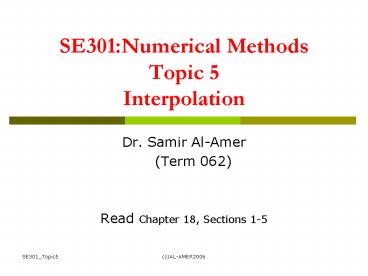SE301:Numerical Methods Topic 5 Interpolation - PowerPoint PPT Presentation
1 / 49
Title:
SE301:Numerical Methods Topic 5 Interpolation
Description:
both Newton's interpolation method and Lagrange interpolation method. must give the same answer ... Lagrange interpolation. others. Polynomial interpolation can ... – PowerPoint PPT presentation
Number of Views:1197
Avg rating:3.0/5.0
Title: SE301:Numerical Methods Topic 5 Interpolation
1
SE301Numerical MethodsTopic 5Interpolation
- Dr. Samir Al-Amer
- (Term 062)
- Read Chapter 18, Sections 1-5
2
SE301Numerical MethodsLecture 14Introduction
to Interpolation
- Introduction
- Interpolation problem
- Existence and uniqueness
- Linear and Quadratic interpolation
- Newtons Divided Difference method
- Properties of Divided Differences
3
Introduction
- Interpolation was used for long time to
provide an estimate of a tabulated function at
values that are not available in the table. - What is sin (0.15)?
Using Linear Interpolation sin (0.15) 0.1493
True value( 4 decimal digits) sin (0.15) 0.1494
4
The interpolation Problem
- Given a set of n1 points,
- find an nth order polynomial
- that passes through all points
5
Example
- An experiment is used to determine the
viscosity of water as a function of
temperature. The following table is generated - Problem Estimate the viscosity when the
temperature is 8 degrees.
6
Interpolation Problem
- Find a polynomial that fit the data points
exactly.
Linear Interpolation V(T) 1.73 - 0.0422 T
V(8) 1.3924
7
Existence and Uniqueness
- Given a set of n1 points
- Assumption are distinct
- Theorem
- There is a unique polynomial fn(x) of order n
such that
8
Examples of Polynomial Interpolation
- Linear Interpolation
- Given any two points, there is one polynomial of
order 1 that passes through the two points.
- Quadratic Interpolation
- Given any three points there is one
polynomial of order 2 that passes through the
three points.
9
Linear Interpolation
475
- Given any two points,
- The line that interpolates the two points is
- Example
- find a polynomial that interpolates (1,2) and
(2,4)
10
Quadratic Interpolation
477
- Given any three points,
- The polynomial that interpolates the three
points is
11
General nth order Interpolation
- Given any n1 points,
- The polynomial that interpolates all points is
12
Divided Differences
13
Divided Difference Table
14
Divided Difference Table
Entries of the divided difference table are
obtained from the data table using simple
operations
15
Divided Difference Table
The first two column of the table are the data
columns Third column first order
differences Fourth column Second order
differences
16
Divided Difference Table
17
Divided Difference Table
18
Divided Difference Table
19
Divided Difference Table
f2(x) Fx0Fx0,x1 (x-x0)Fx0,x1,x2
(x-x0)(x-x1)
20
Two Examples
Obtain the interpolating polynomials for the two
examples
What do you observe?
21
Two Examples
Ordering the points should not affect the
interpolating polynomial
22
Properties of divided Difference
Ordering the points should not affect the divided
difference
23
Example
- Find a polynomial to interpolate the data.
24
Example
25
Summary
26
SE301 Numerical MethodsLecture 15 Lagrange
Interpolation
- Dr. Samir Al-Amer
- (Term 051)
27
The interpolation Problem
- Given a set of n1 points,
- find an nth order polynomial
- that passes through all points
28
Lagrange Interpolation
486
- Problem
- Given
- Find the polynomial of least order
such that - Lagrange Interpolation Formula
29
Lagrange Interpolation
30
Lagrange Interpolation Example
31
Example
- find a polynomial to interpolate
- both Newtons interpolation method and Lagrange
interpolation method - must give the same answer
32
(No Transcript)
33
Interpolating Polynomial
34
Interpolating Polynomial Using Lagrange
Interpolation method
35
SE301Numerical MethodsLecture 16Inverse
interpolation Error in polynomial interpolation
- Dr. Samir Al-Amer
- (Term 042)
36
Inverse Interpolation
491
One approach Use polynomial interpolation to
obtain fn(x) to interpolate the data then use
Newtons method to find a solution to
37
Inverse InterpolationAlternative Approach
Inverse interpolation 1. Exchange the roles of
x and y 2. Perform polynomial Interpolation
on the new table. 3. Evaluate
38
Inverse Interpolation
x
y
x
y
39
Inverse Interpolation
Question What is the limitation of inverse
interpolation
- The original function has an inverse
- y1,y2,,yn must be distinct.
40
Inverse Interpolation Example
41
10 th order Polynomial Interpolation
42
Errors in polynomial Interpolation
- Polynomial interpolation may lead to large error
(especially for high order polynomials) - BE CAREFUL
- When an nth order interpolating polynomial is
used, the error is related to the (n1) th order
derivative
43
Errors in polynomial InterpolationTheorem
44
Example 1
45
Interpolation Error
Not useful. Why?
46
Approximation of the Interpolation Error
47
Divided Difference Theorem
48
Summary
- The interpolating polynomial is unique
- Different methods can be used to obtain it
- Newtons Divided difference
- Lagrange interpolation
- others
- Polynomial interpolation can be sensitive to
data. - BE CAREFUL when high order polynomials are used
49
HW
- Chick WebCT for HW problems and due dates































